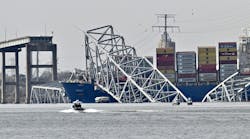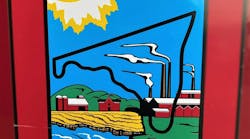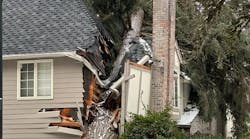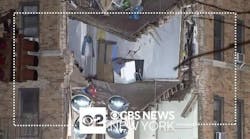The most frequent collapse-related incident that most fire departments respond to is a vehicle that struck a building. Often, the vehicle remains outside of the building, but many incidents present a scenario in which the vehicle is partially or completely inside of the building. Even in the absence of a life-threatening situation that requires members to rescue trapped occupants, shoring operations still might need to be conducted by crews.
As with all incidents, deciding on the proper course of action at a vehicle vs. building call begins with size up.
Shoring
First and foremost, responders must determine whether there’s an immediate life threat to people who are in the crashed vehicle, occupants of the building or other people who are in the vicinity.
- Jake Hoffman will present “The Rescue Mindset" and "Rescue Company Tips and Tricks” at Firehouse Expo 2023.
When one assesses the damage to the building, it’s natural to focus on the area of greatest apparent damage, which often is where the vehicle struck the building; however, a more comprehensive analysis of the building is required to accurately determine the risks that are present at the incident.
After the construction type is identified, FEMA’s guide for shoring basics for structural collapse technicians can be utilized as an aid to recognize the modes of failure and “check points,” or indicators, for potential areas of concern.
The structural assessment process should include a six-sided survey of the building to not only observe all of the sides of the structure via a 360-degree walk-around but also to consider what’s above and below the area of concern.
In evaluating the loads and forces from above, firefighters should estimate the weight of the area of concern and attempt to determine how these forces are being transferred through structural members that might be compromised, having not been designed to take such a load.
The guiding principle of shoring is that a load must be captured, transferred and redistributed. For this reason, the area that’s below a damaged area must be evaluated for its capability to safely redistribute the potential load. For example, a general rule in wood-frame construction is one undamaged floor is required to support one damaged floor. Although damage at the point of collision might be obvious on arrival, conducting a 360 allows rescuers to observe whether the entire building shifted on its foundation or is out of plumb or whether other complications exist.
The six-sided survey isn’t solely an exterior tool but also should be used to guide interior assessment. Particularly in cases in which there’s no immediate threat to life, crews should attempt to gain access into the structure from an undamaged area and work their way toward the most damaged area. For example, although the effect of a vehicle that strikes the porch of a house might be limited mostly to the porch roof, a vehicle that completely enters the house not only affects an exterior wall but presents a live load into the structure that most likely must be evaluated and accounted for in the final shoring plan.
Rescuers should open walls and ceilings to expose structural members. The purpose is to visualize any damage that might be hidden behind the drywall or plaster. This helps to determine the direction of floor joists and to ensure that any actions that are taken won’t be “pseudo-shoring” that might look good but doesn’t collect, transfer and redistribute the load to maintain stability of the structure.Property conservation
Often, these incidents don’t result in persons being trapped or in need of rescue, so decisions must be made regarding actions to conserve property. These decisions often are a function of multiple factors, including member training, available equipment and other calls for service that might preclude the department from devoting a large contingent of personnel to what can become a longer-than-normal incident response.
Two life-safety considerations that often are overlooked by responders to vehicle vs. building incidents are the safety of law enforcement personnel who conduct the crash investigation and of towing operators who recover the vehicle.
Although the force that’s generated by a vehicle when it strikes a building typically is greater than the force that might be involved with disentangling and removing the vehicle, it’s important to remember that removing the vehicle is a dynamic event that can cause subsequent collapse if actions aren’t taken to mitigate possible effects.
Rescuers should evaluate whether any shoring is needed to prevent the situation from becoming worse than it is.
Thinking beyond the obvious
Additional considerations for vehicle vs. building incidents include weather, vacant structures, liability and insurance claims.
When such incidents occur during or just before inclement weather, such as thunderstorms, snow, etc., consideration must be given to the effect that these forces might have on the structure.
If the building that was struck is vacant or unoccupied, after completing a search of the building, the incident commander (IC) must review the potential for injury to unauthorized persons, such as children and squatters, who might enter the damaged building after emergency personnel leave the scene. The same goes regarding the possibility of further deterioration or collapse of the building that could lead to damage of adjoining structures, impeding vehicle or pedestrian traffic and/or affecting utilities.
Departments should contact their legal counsel to determine what their liability might be in such situations. When vehicles hit a building that’s insured, it often is tempting for personnel to justify no action by stating that “the building owner’s insurance will take care of it.” However, it’s important to remember that property conservation is one of the building blocks of the fire service and that throwing up a simple shore with less than $100 of materials not only might prevent further property damage but also might protect the life of the towing personnel who are tasked with removing the vehicle.
Outside expertise
In a world in which fire departments routinely are asked to do more with less, subject matter experts should be consulted on all vehicle vs. building incidents. Department personnel who have structural collapse training often are an obvious and easy choice for such purposes; however, relationships should be built with external subject matter experts, too.
Many departments are capable of working in conjunction with their municipality’s buildings department, a city or county engineer and/or private engineering firms that provide a wealth of knowledge and can help the IC to make an informed decision. It’s important to develop these relationships prior to an incident, so first introductions aren’t made in the middle of the night during a stressful incident. These individuals should be introduced to the basic concepts of structural collapse rescue, to designs and testing of shoring systems that are used by rescue teams and to how the individuals’ expertise/knowledge supports the overall response model for vehicle vs. building incidents.
Fundamental safety
When operating in or near a damaged structure, certain fundamental safety precautions must be taken.
First, rescuers should remember the acronym LCES, which stands for Lookouts, Communications, Escape Routes and Safety Zones. Prior to committing to a potentially dangerous area, whether for reconnaissance or rescue purposes, rescuers must identify potential emergency egress points and areas of refuge that can be used if unintended movement or secondary collapse occurs.
Second, rescuers always should attempt to approach from the undamaged or least damaged area of the building as they move toward the area of most damage. This often is the easiest way to plan for escape routes and safety zones.
There are two primary types of shoring at a vehicle vs. building incident. The first type occurs at incidents that have an imminent life-safety concern and often relies on shores that can be placed quickly to reduce risk during extrication operations. Manufactured shoring systems are well suited to this task, because they require minimal measurement, no cutting of lumber and minimal exposure in unshored areas. (Note: Manufactured shoring systems might be indicated for limited to moderate damage situations. Be sure to check the manufacturer’s specifications.)
Depending on the complexity of the incident, progressive shoring operations might be required where “spot shores” quickly are placed while more complex shoring systems are built; other incidents might require only relatively simple Class 1 shores.
When placing shores to allow for extrication operations, rescuers should do everything possible to locate the shores in a position that captures the needed load but won’t impede the rescue. An example of this would be placing a two-post shore to span the area where rescue personnel normally might place a T-spot shore.
The second type of shoring is that which is needed to permit safe removal of the vehicle or to prevent further damage to the building. Because these shoring operations take place after rescue operations or when there’s no life-safety concern from the start of the operation, they often are more methodical than the first type.
If manufactured rescue shoring systems are used for the operation, consideration must be given to how this expensive equipment will be removed by the department. Wood shoring most likely will have to be constructed and placed to retrieve the manufactured system.
Another option for replacement shoring is steel jack post columns, which commonly are found in residential construction and can be purchased at a hardware store.
Unique to these incidents
Some extrication considerations are inherent to a vehicle that’s partially or completely inside of a structure.
Crews first should have a four-gas meter in operation. Continuous atmospheric monitoring could alert rescuers to a leak from the vehicle’s fuel tank, a previously undetected natural gas leak or increased carbon monoxide levels because of the running vehicle or the operation of gasoline-powered tools and generators.
Next, rescuers should make room to work but ensure that such movement doesn’t make matters worse. This typically entails the removal or rearrangement of furniture or furnishings that are in the work area. Rather than simply moving them to another room, rescuers should try to remove furnishings and obstructions from the structure entirely, perhaps via the nearest window, to both create space and to reduce the live load that’s on the structure.
Lastly, consideration must be given to how each particular tactic or operation affects not only the vehicle and its occupants but the structure, too. For example, lifting or displacing the vehicle easily can overwhelm damaged structural components. Additionally, the “equal and opposite reaction” to rescue actions can prove not only unsuccessful but could lead to unintended consequences, such as structural failure, secondary collapse, and injury to rescuers and victims.
Laying the groundwork
The considerations that are listed above help to provide a guide for handling the initial phases of vehicle vs. building calls. They also can lead to the development or continuation of relationships with both private and public sector partners prior to an incident occurring.







